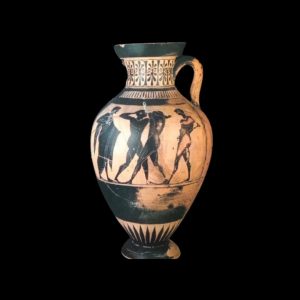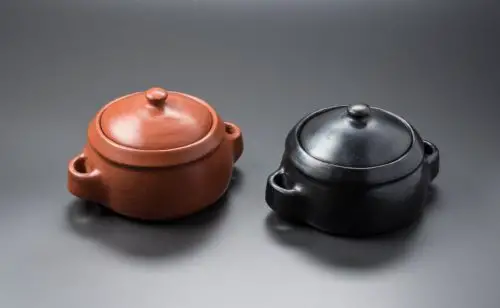Did you know that we could learn about the development of an entire culture from a simple piece of pottery? It is the same with Greek culture, which ceramics brings us closer to thanks to its knowledge of art and its way of capturing history.
Table of Contents
In what year did ceramics come to Greece?
Thanks to the knowledge of their ancestors, the Greeks were able to create magnificent ceramic pieces. Greek pottery thus became one of the most famous in the world.
It is characterized by the many details and embellishments in each of her pieces, which, through the characters, reflect the whole history of this culture.
The pottery of the Greeks began during the Preclassic period from 2000 to 250 BC. It is thanks to the Greeks that ceramic vessels exist today. They began to make them for transporting various foods such as water and wine.
Most pottery producers were slaves trying to regain their freedom.
Slaves were an important pillar of Greek craftsmanship.
Characteristics of pottery in Greece
There are some things that distinguish Greek pottery from all other potteries in the world. There are three characteristics that will help you distinguish them very quickly:
- The pots were decorated with red figures on a dark background. At other times they were decorated in reverse, with black or brown figures on a red background.
- The decoration of the pieces consisted of drawings that not only depicted aspects of their culture such as customs, wars, and the type of institution they lived in but also told typical mythological stories.
The most important drawings in their works were animal and human forms, as well as numerous geometric elements in strips. These drawings were so important in Greek pottery that the Greeks decided to make molds to better make the figures. Because they knew that they were telling their story and wanted people to understand them. - The pieces were an orange color that came from clay containing iron oxide, which turned into this amazing color when it dried.
The type of clay they used depended on the places from which they extracted it. Because the sound was not mined anywhere, but in very specific places. Such is the case with the Athenian clay, which was responsible for the orange color.
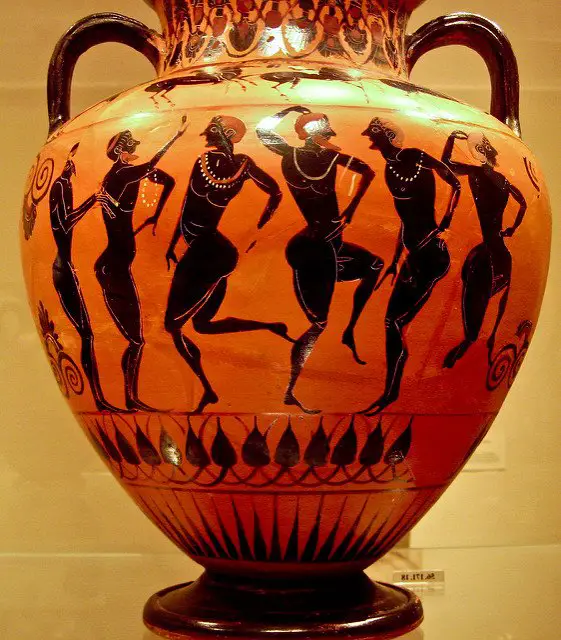
Pottery styles in Greece
The following 4 styles are the most important that exist in the history of Greek pottery from 1050 to 525 BC. gave.
Protogeometric style
This style dates from the Protogeometric Period, an archaeological period in Ancient Greece from 1050 to 900 BC. Chr. It is characterized by vessels with a very simple decoration, using both ancient techniques and other techniques emerging at the time.
With the Protogeometric style, they wanted to follow in the footsteps of the Mycenaean motifs, which are essentially a decoration based on marine and plant motifs.
That is why these motifs can be found alongside other techniques in the pieces of this period.
To create these pieces, they used a fast lathe, compasses, and brushes with different tips to create concentric motifs so that each piece had the same center.
The vertical and horizontal lines that run around the neck or belly of the vessels or vases are particularly characteristic of the pieces of this style. Circles, semicircles, triangles, and squares were also used as additional decoration.

Geometric style
This style is known to date from the 9th to 8th centuries BC. BC is quite different from the typical Minoan motifs, which depict naturalistic figures such as octopuses and flowers, and from the Mycenaean motifs, which, as mentioned above, are sea figures.
The geometric style, as the name suggests, is characterized by geometric figures such as B. Triangles arranged in bands separated by lines of three.
Over the years, not only geometric figures were used, but also animal decorations such as horses, deer, goats, and many more, alternating with the bands of traditional geometric motifs.
Years later, in the mid-8th century B.C. BC, the Greeks began to depict human figures appearing in parades of warriors with chariots and shields. These vases, as they were called, were called “Dipylon vases”.
In this style, the Greeks painted mythological scenes on the pottery. This was around the same time Homer was compiling the entire Trojan cycle in the Iliad and the Odyssey.

Black figures
We now come to one of the two most important and distinctive styles of Greek pottery.
The black figures evolved between 570 and 525 BC. and left all the development towards geometry that had taken place in the years before, as well as the ribbons that were so important.
The pieces, which were typically vases, began to feature a single theme in the middle of the piece. What fully characterizes this style and gives it its name are the drawings of human figures in black color on an orange part of the piece, due to the type of clay used.
In these figures, more than in the others, their entire history is represented, and above all, they show us how warlike Greek culture was because the figures represent strong warriors fighting with their shields, helmets, spears, and swords.
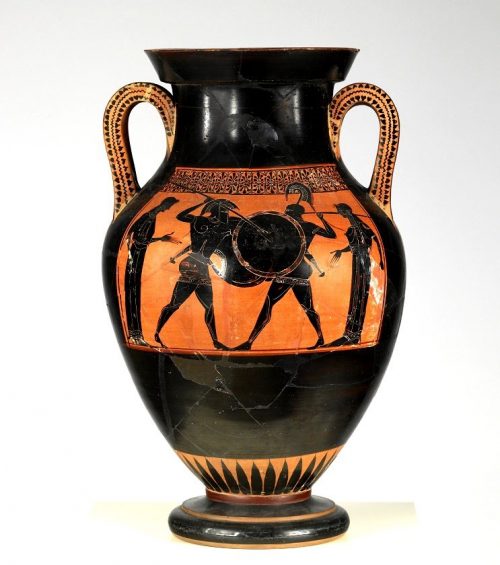
Red Figures
We know this style dates back to the end of the 6th century BC. B.C., but not until the 5th century B.C. It became so well-known and prevailed so strongly. Scenes depicted in this style are more detailed than the black figures due to perspective effects and a sense of spatial reality.
This sense of spatial reality means that one can easily identify the space each of the characters is in. For example, when one person is in front of or behind another, as you can see in the image below.
This is the opposite of the black pieces. In this style, the characters are in red, the color of the clay, and the background is black to make the drawings stand out better. And although the scenes are almost the same, the figures were more delicate and the motifs more complicated to design.
They managed to portray very well people’s musculature, facial features, hair ornaments, and other things that we can see very well if we look closely.
Because the two styles of black and red figures coexisted early in this period, these styles together have been referred to as “bilingual pottery”.
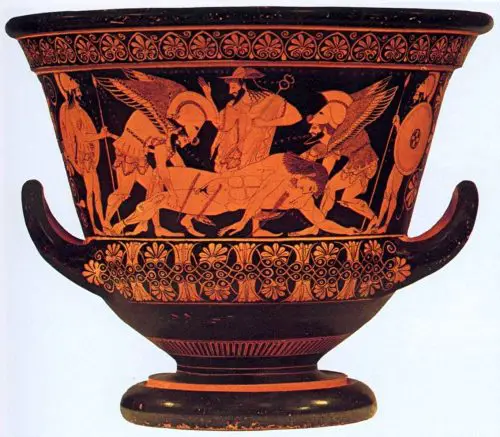
How were red figures made in Greek pottery?
The elaboration of these pieces has taken a lot of time at each step to achieve the spectacular and unique result. Here we will explain to you step by step how the Greeks made their pottery:
- Various types of clay were used in the manufacture of Greek pottery, which, as we have already said, came from certain places still unknown.
- The clay was cleaned by leaving it in water for a few weeks.
- When the clay was ready, it was kneaded and mixed with water very well so that there were no water bubbles in it.
- This mixture was strained and left on the stone wheel or lathe to begin modeling the piece.
- After modeling the vessel or vase, it was fired in a kiln at 800°C.
- During the first firing, the clay oxidized, giving rise to the characteristic red or orange color.
- The piece was given to the painter who drew the sketch of the design.
- After completing the sketch, the painter covered the black areas with varnish.
- The second firing started at 950°C, closing the kiln slightly to keep the air out and also feeding the fire with leaves and green wood to create smoke to turn the lacquer black.
- The kiln was uncovered to allow air to enter and help cool the piece, causing it to oxidize again, turning the areas where there was no lacquer into red color.

